Leaf structure, description, and modifications.

Leaf structure, description, and modifications.
Leaves, which are initiated as primordia by the apical meristems, are vital to life as we know it because they are the principal sites of photosynthesis on land, providing the base of the food chain.
Leaves expand by cell enlargement and cell division at the apical meristem.
Most leaves are usually green, due to the presence of chlorophyll in the leaf cells.
However, some leaves may have different colors, caused by other plant pigments that mask the green chlorophyll.
The leaves’ thickness, shape, and size are adapted to the environment.
Each variation helps a plant species maximize its chances of survival in a particular habitat.
Structure of the leave:

- Leave has a leaf blade called the lamina, which is also the widest part of the leaf.
- Some leaves are attached to the plant stem by a petiole, but some do not have a petiole.
- A leaf without a petiole is known as a sessile leaf.
- Most leaves also have a midrib which travels the length of the leaf.
- The midrib branches to each side of the leaf to produce veins of vascular tissue.
- The edge of the leaf is called the margin.
Classification or description of leaves
Leaves of a plant are classified or described according to;
- How leaves are arranged on the stem.
- Type of lamina/leaf blade (leaf form).
- The shape of the leaf blade/lamina.
- The leaf margin/edge.
- Vernation
Description of leaves based on the arrangement of leaves on the stem.
- The arrangement of leaves on a stem is called
- The phyllotaxy of leaves on stems varies.
- The arrangement of leaves on a stem is usually determined genetically, so these characteristics are often used for plant identification.
- The arrangement may be described as;
Alternate:
- These are plants that have only one leaf per node.
- The leaves alternate on each side of the stem in a flat plane.
It can be found in plants such as;
- Talinum
- Bougainvillea
- Rose
- Balsam
- Cassava
- Maize
- Guinea grass/elephant grass.

Opposite/Decussate phyllotaxy:
In an opposite phyllotaxy, two leaves arise at the same point, with the leaves connecting opposite each other along the branch.
It can be found in
- Ixora
- Guava
- Tridax
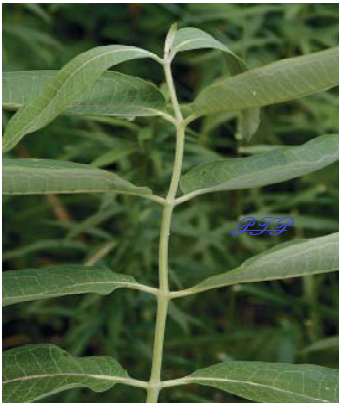
Whorl phyllotaxy:
It occurs when there are three or more leaves connected at a node on the stem.
It can be found in Allamanda.

Rosette phyllotaxy:
All leaves occur in a cluster at the base of a short or non-existing stem.
Where internodes are extremely short leading to a rosette growth form.
It can be found in;
- Water lettuce.
- Cabbage
- Aloe
- Onion
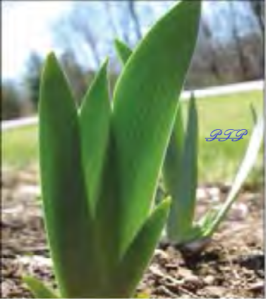
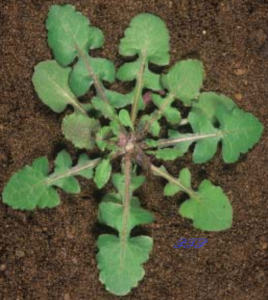
Description of leaves based on the type of leaf blade/lamina.
Leaves may be simple or compound.
A simple leaf:
A simple leaf is a type of leaf with a single lamina or leaf blade.
Examples are;
- Crotalaria
- Tridax
- Mango
- Talinum
It may also have lobes, but the separation does not reach the midrib.
Example is cassava
A compound leaf:
In a compound leaf, the leaf blade is completely divided, forming leaflets.
Each leaflet may have its stalk but is attached to the rachis.
Compound leaves include:
A palmately compound leaf.
The leaf resembles the palm of a hand with leaflets radiating outwards from one point.
Examples include;
- the leaves of poison ivy,
- the buckeye tree, or the familiar houseplant Schefflera sp. (common name “umbrella plant”).
- Pawpaw
- Castor oil.
- Sweet potato.
Pinnately compound leaves:
They take their name from their feather-like appearance; the leaflets are arranged along the midrib.
Or the leaflets are arranged along the main stalk.
Examples include:
- Rose leaves (Rosa sp.),
- The leaves of hickory, pecan, ash, or walnut trees.
- The leave of Cassia
- The leave of the neem tree.
- Tomato
- Lucinia
Bipinnate or double compound leaves:
It is also a compound leaf in which each pinnate leaflet is divided into pinnate leaflets called pinnules.
Example include;
- Flamboyant
- Mimosa.
Classification of leaves based on the leaf margin/edge.
This is what the edge of the leaf looks like.
These include:
Entire margin.
It is the leaf with a smooth edge.
Examples are;
- Crotalaria
- Commelina sp.
- Mango
- Ixora sp.
- Allamanda
- Elephant grass/guinea grass.
Serrated margin.
The edge of the leaves is toothed but the tooth is bent towards the apex.
It may also be small but sharp teeth and point towards the apex/tip of the leave.
Examples are;
- Hibiscus
- Tridax
- Sida acuta
Dentate margin.
In this type of leaf, the edges are toothed as well but the teeth are large and blunt.
The teeth are also pointing outward and not bent.
Lobed margin.
The edges of this type of leaf are divided but the divisions do not get to the center of the leaf blade.
An example is cassava leaf.
Description of leaf according to venation.
Venation is the arrangement of veins in a leaf blade or lamina of a leave.
Or it is the pattern of veins in the leaf blade.
These include:
Pinnate venation.
In pinnate venation, a single main vein (midrib) from which smaller lateral veins diverge in a feather-like pattern.
Major veins originate from points along the centrally placed main vein (midrib).
Palmate venation.
In a palmate venation also, the major veins all originate at the point of attachment of the blade to the petiole.
Or several main veins may spread from a common point on the petiole like the fingers of your hand.
Parallel venation:
In this type of venation, the veins in the leaf radiates from a point on the petiole to the apex of the leaf and none of the vein crosses each other.
It is normally found in grasses or monocots.
Reticulate/net venation
The veins branch across each other in a net-like manner.
It is normally found in dicots.
Other descriptions may be according to;
- the type/shape of the tip/apex of the leave
- base of the blade
- according to the petiole.
Leave modifications.
As plants colonized a wide variety of environments, from deserts to lakes to tropical rainforests, plant organ modifications arose that would adapt the plants to their specific habitats.
Leaves, in particular, have evolved some remarkable adaptations.
Some of the modifications in leaves are;
Floral leaves (bracts)/ floral mimic.
- Poinsettias and dogwoods have relatively inconspicuous, small, greenish-yellow flowers.
- However, both plants produce large modified leaves called bracts (mostly colored red in poinsettias and white or pink in dogwoods).
- These bracts surround the true flowers and perform the same function as showy petals.
- In other plants, however, bracts can be quite small and inconspicuous.
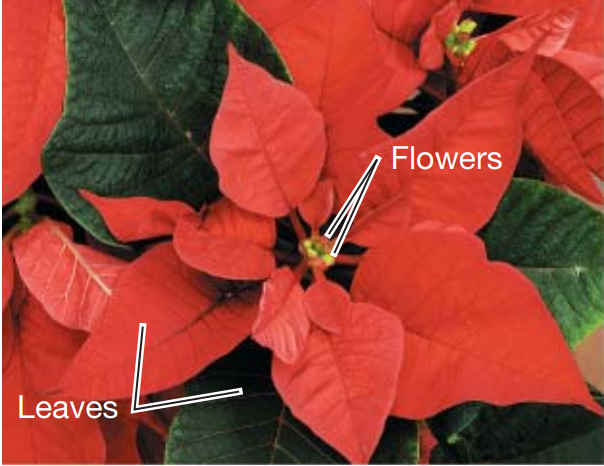
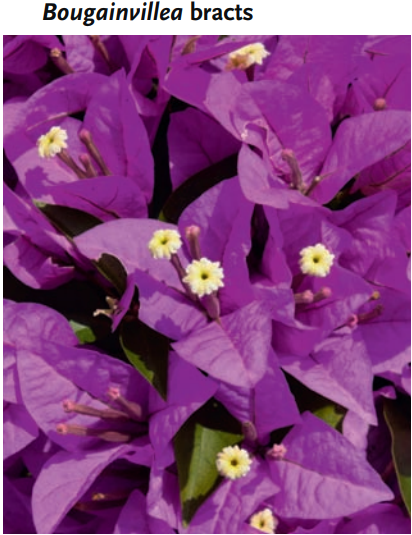
Spines.
The leaves of many cacti and other plants are modified as spines.
In cacti, having less leaf surface reduces water loss, and the sharp spines also may deter predators.
Spines should not be confused with thorns, such as those on the honey locust (Gleditsia triacanthos), which are modified stems, or with the prickles on raspberries, which are simply outgrowths from the epidermis or the cortex just beneath it.
Spine formation is also an adaptive feature to conserve water.
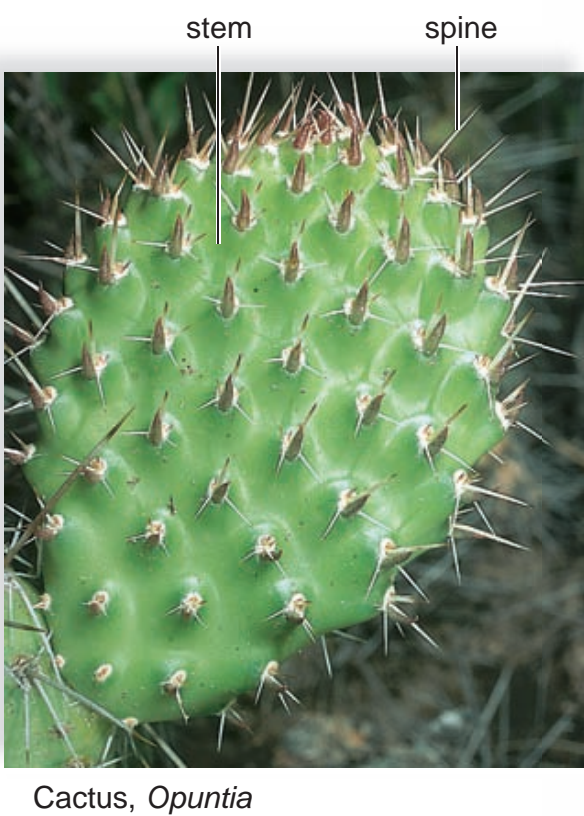
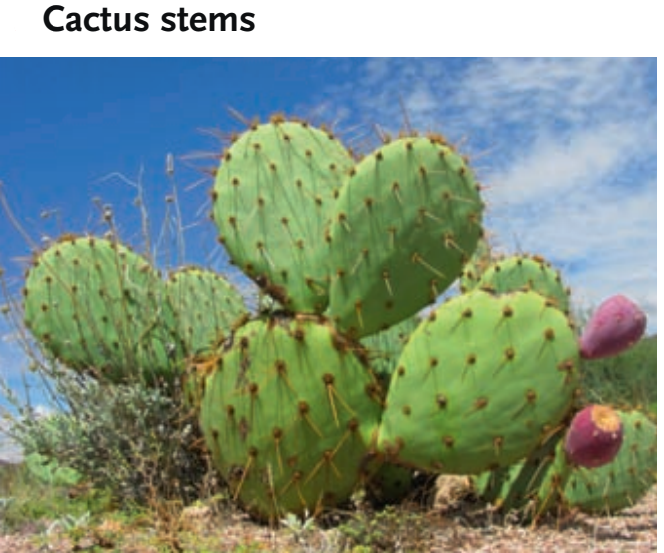
Reproductive leaves.
- Several plants, notably Kalanchoe, produce tiny but complete plantlets along their margins.
- Each plantlet, when separated from the leaf, is capable of growing independently into a full-sized plant.
- The walking fern (Asplenium rhizophyllum) produces new plantlets at the tips of its fronds.
- Although many species can regenerate a whole plant from isolated leaf tissue, this in vivo regeneration is found among just a few species.
Storage leave.
These are leaves modified as storage organs and may store water or food.
An onion bulb is made up of leaves surrounding a short stem.
In a head of cabbage, large leaves overlap one another.
The petiole of a leaf can be thick and fleshy, as in celery and rhubarb.
Aloe vera is modified to store water.


Insectivorous leaves.
- Almost 200 species of flowering plants are known to have leaves that trap insects.
- Some plants digest the insects’ soft parts.
- Plants with insectivorous leaves often grow in acid swamps that are deficient in needed elements or contain elements in forms not readily available to the plants.
- This inhibits the plants’ capacities to maintain metabolic processes needed for their growth and reproduction.
- Their needs are met, however, by the supplementary absorption of nutrients from the animal kingdom.
- The pitcher plants are examples of plants that trap insects.
- When insects enter, they feed on the plant’s nectar and appear to become dizzy.
- Eventually they fall into the bottom of the tube and drown in water that has accumulated.
- The insects are then digested by bacteria or enzymes secreted by the plant, and the plant absorbs the nutrients released.

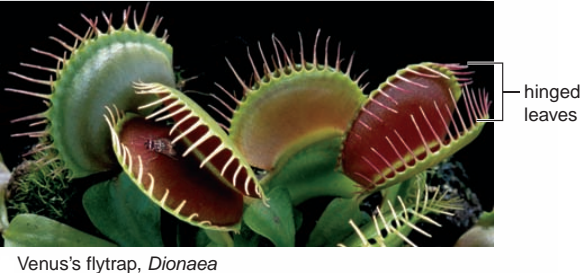
Other examples are;
- Sundew (Drosera)
- Venus flytrap (Dionaea muscipula)
Internal Structure of a leaf.
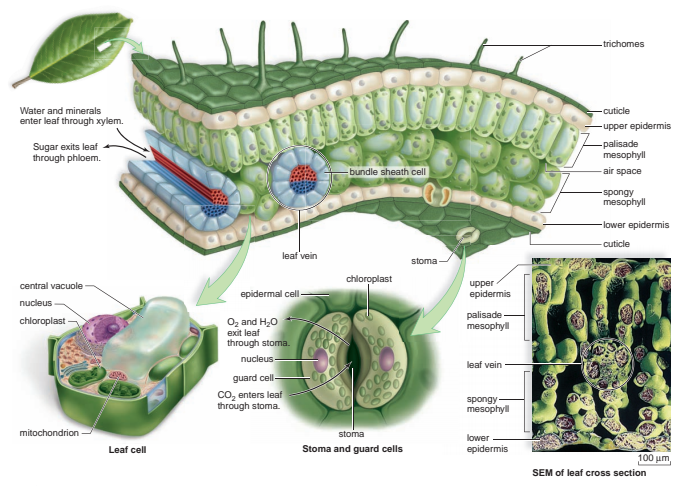



Join Enlighten Knowledge WhatsApp Channel.
Join Enlighten Knowledge Telegram platform.





